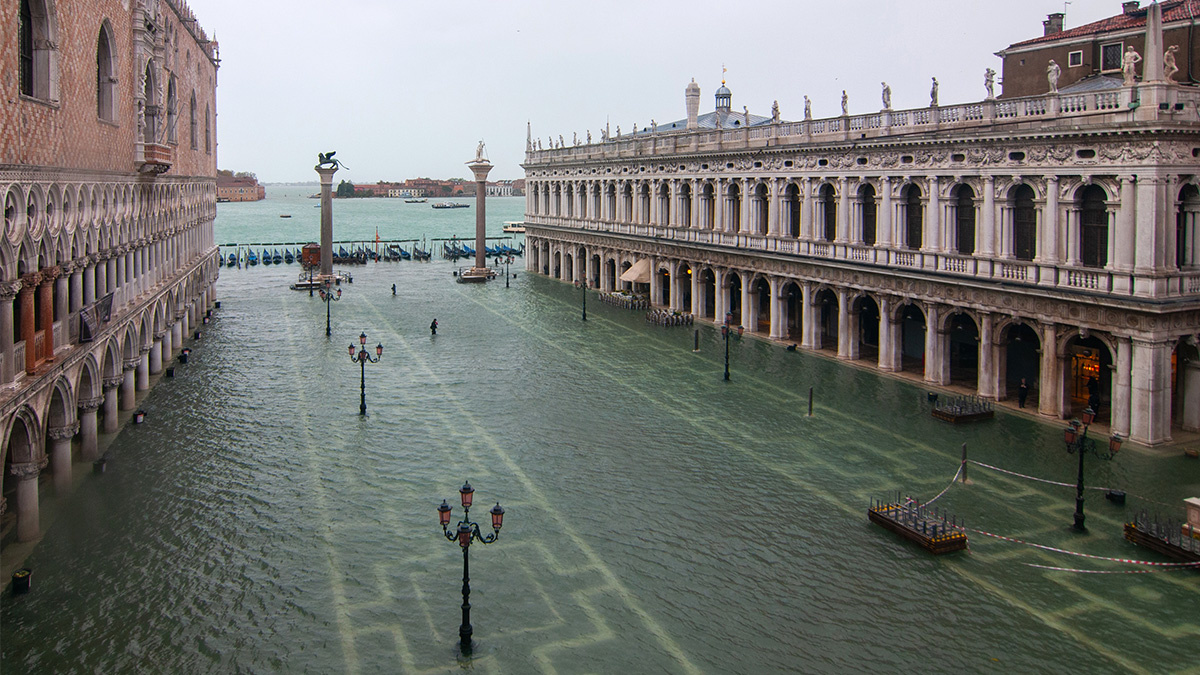
Veneto Council Flooded Two Minutes After Rejecting Climate Action, Councilor Says

A flooded St. Mark's square (Piazza San Marco) during a new exceptional high tide on Nov. 15 in Venice, Italy. Simone Padovani / Awakening / Getty Images
The historic “acqua alta” that swamped Venice Tuesday night also flooded the Veneto regional council for the first time, just moments after it had apparently rejected measures to address the climate crisis.
The council chamber, which is located on Venice’s Grand Canal in the Ferro Fini Palace, began to flood around 10 p.m. Tuesday, CNN reported. At the time, the councilors were discussing the 2020 budget for the northeastern Italian region of Veneto, of which Venice is the capital.
“Ironically, the chamber was flooded two minutes after the majority League, Brothers of Italy, and Forza Italia parties rejected our amendments to tackle climate change,” Democratic Party councilor and environment committee deputy chairman Andrea Zanoni wrote in a Facebook post reported by CNN.
The League and Brothers of Italy are far-right parties, and Forza Italia is a center-right party, HuffPost explained.
LA LEGA DI ZAIA VOTA CONTRO I NOSTRI EMENDAMENTI SUL CONTRASTO AI CAMBIAMENTI CLIMATICI E DOPO DUE MINUTI L’AULA…
Posted by Andrea Zanoni on Wednesday, November 13, 2019
The rejected amendments included plans to fund renewable energy, replace diesel buses with cleaner and more efficient vehicles, replace high-polluting stoves and tackle plastic pollution, Zanoni said.
Zanoni further said that Veneto regional president and League member Luca Zaia presented a budget “with no concrete actions to combat climate change,” CNN reported.
Zanoni joined Venice Mayor Luigi Brugnaro in blaming climate change for Venice’s massive flooding Tuesday, according to HuffPost, though he acknowledged it was one of many factors responsible. The city saw its highest tide in more than 50 years when water levels peaked at more than six feet.
There are no words to express all this #VeniceFloods #ClimateEmergency pic.twitter.com/Kufh6NhPqm
— Giovanni Antonelli (@G_Antonelli_) November 14, 2019
“If the voters of Veneto continue to close their eyes, Zaia’s League will bring us all underwater,” Zanoni said, according to HuffPost.
Regional council spokesman Alessandro Ovizach confirmed to CNN that the flooding occurred during the 2020 budget discussion, but did not specify which budget items were being addressed at the time.
But council president and League member Roberto Ciambetti disputed Zanoni’s depiction of the council’s actions on climate.
“Beyond propaganda and deceptive reading, we are voting (for) a regional budget that spent €965 million over the past three years in the fight against air pollution, smog, which is a determining factor in climate change,” he said in a statement to CNN. “To say that we do nothing is a lie.”
Ciambetti did acknowledge the flooding, and posted videos of it on his Facebook page.
“Never had such a situation occurred here (at the Council),” he told local paper Giornale di Vicenza, according to CNN.
L'aula consiliare della Regione del Veneto
Posted by Roberto Ciambetti on Tuesday, November 12, 2019
The Italian government declared a state of emergency Thursday to help Venice recover, NPR reported.
The flooding has also continued after Tuesday, though at lower levels. On Thursday, the high water mark came to three feet, eight inches, and rain is expected to bring more flooding to the city.
“It hurts to see the city so damaged, its artistic heritage compromised, its commercial activities on its knees,” Italian Prime Minister Giuseppe Conte said, according to NPR.
Flooding damaged almost a third of the city’s raised walkways, destroyed hundreds of books in the Acqua Alta Library and filled the crypt of St. Mark’s Basilica, causing major damage. The Teatro La Fenice opera house was also damaged, The Guardian reported.
“An apocalypse happened,” Antonella Rossi, who owns a handmade jewelry store on St. Mark’s Square, told The Guardian. “We haven’t seen anything like this in 55 years. The water has destroyed everything, and I will have to redo so much – work that took a lifetime was wrecked in seconds.”
BBC News meteorologist Nikki Berry explained how the climate crisis contributed to the historic flooding. While it is difficult to attribute any one extreme weather event to climate change, five of Venice’s 10 highest tides took place in the last 20 years. Since Venice is sinking, it is especially susceptible to sea level rise.
The storm surge that contributed to the flooding also shows the fingerprints of climate change, Berry explained:
The weather patterns that have caused the Adriatic storm surge have been driven by a strong meridional (waving) jet stream across the northern hemisphere and this has fed a conveyor belt of low pressure systems into the central Mediterranean.
One of the possible effects of a changing climate is that the jet stream will be more frequently meridional and blocked weather patterns such as these will also become more frequent. If this happens, there is a greater likelihood that these events will combine with astronomical spring tides and hence increase the chance of flooding in Venice.
Conte said the government would work to “accelerate” construction on the long-delayed Mose project, designed to protect Venice from flooding using a series of barriers, according to BBC News.
- These Iconic Mediterranean Landmarks are Currently at Risk from ...
- 70% of Venice Flooded by Highest Tide in at Least a Decade ...
- Venice Flood Barrier Passes First Major Test - EcoWatch

 233k
233k  41k
41k  Subscribe
Subscribe 